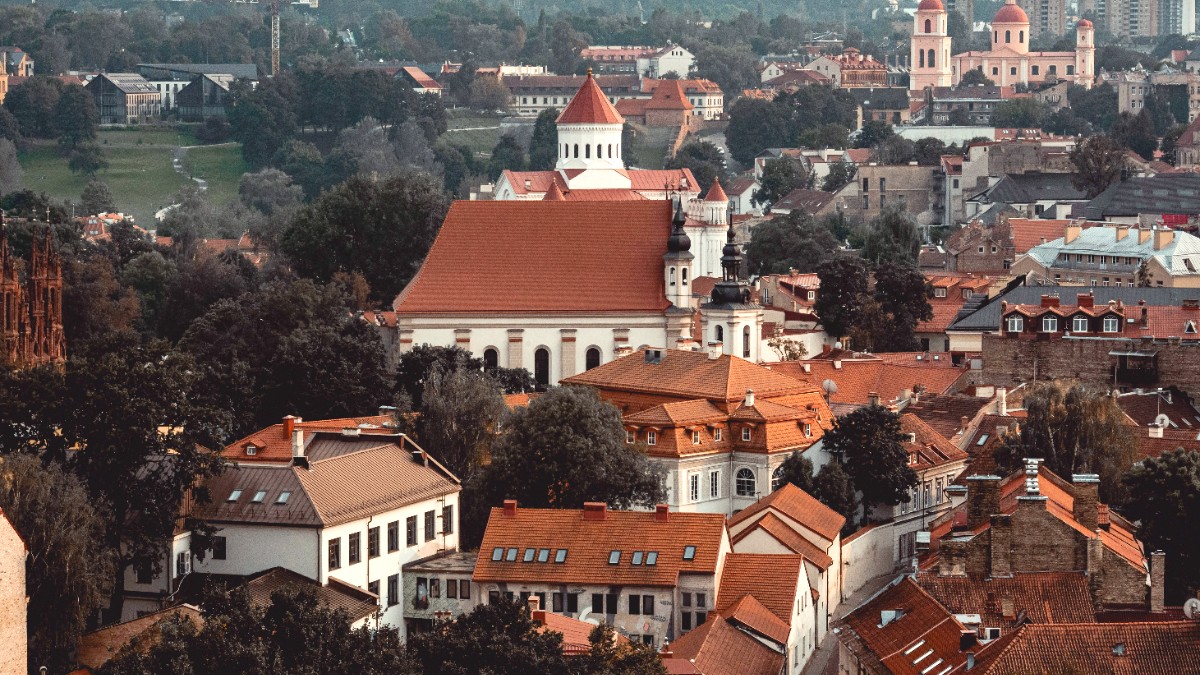
Lithuania
A visit brings hidden courtyards, grand palaces, and a warmth that invites you to linger.
Vilnius is strategically located in the southeastern part of Lithuania, at the meeting point of the Vilnia and Neris Rivers. These rivers have shaped the city's development, giving waterways for trade and defense, and contributing to its picturesque landscape. The city’s coordinates are approximately 54°41′N 25°17′E. This northern European positioning affects its climate and daylight patterns throughout the year, giving distinct seasonal experiences.
The city’s elevation varies, with its historical center typically situated around 112 meters (367 feet) above sea level. This varied terrain means you encounter rolling hills, giving natural viewpoints and adding to the city's scenic appeal. The Neris River valley carves a path through the urban landscape, creating lush green spaces along its banks. Vilnius is also prominent for its abundant parks and forests, which make up a significant portion of the city's area. These green zones are not just on the outskirts; they extend into the urban fabric, giving residents and visitors ample opportunities for relaxation and outdoor activities within easy reach of the city center.
Vilnius is a history spanning centuries, a narrative of growth, resilience, and cultural intermingling. Grand Duke Gediminas first mentioned the city in written sources in 1323, marking its formal appearance on the European stage. From this beginning, Vilnius rose to become the capital of the Grand Duchy of Lithuania, a powerful and expansive state in 15th-century Europe. At its height, the Grand Duchy stretched from the Baltic to the Black Sea, making Vilnius a political and cultural center of immense influence.
The city has always been a hub of multiculturalism. Lithuanian, Polish, Jewish, Russian, and Belarusian cultures have shaped its identity over time. This rich blend is evident in its architecture, traditions, and the languages heard on its streets. Vilnius is especially renowned for its exceptionally preserved Old Town, which gained its designation as an UNESCO World Heritage site in 1994. This area showcases a predominant Baroque architectural style, seen in its numerous churches, palaces, and public buildings.
First written mention of Vilnius by Grand Duke Gediminas.
Capital of the Grand Duchy of Lithuania, extending from Baltic to Black Sea.
Historically, a major center of Jewish culture and learning.
Lithuania regained independence, a new era for Vilnius.
Vilnius Historic Centre received UNESCO World Heritage site status.
Vilnius experienced periods of occupation by various powers throughout its history, including Russia, Poland, and the Soviet Union. Each occupation left its mark, contributing to the city's complex narrative but never fully erasing its unique character.
A significant part of Vilnius's past concerns its Jewish heritage. Historically, it was a major center of Jewish culture and learning, earning it the moniker "Jerusalem of the North." Efforts are underway to remember and restore aspects of this past, making it an important part of the city's historical exploration.
These sites allow visitors to appreciate the struggles and triumphs that forged modern Vilnius. The city’s history is not confined to museums; it dwells in the stones of its buildings and the stories of its people.
Explore side streets and courtyards in the Old Town. These often show hidden historical details or charming local businesses not found on the main tourist routes.
Vilnius functions as the capital of the Republic of Lithuania. It is the country's largest city, serving as its main political, economic, and cultural hub. The Vilnius City Municipality is a population of approximately 602,400 residents as of early 2024.
The city covers an area of approximately 401 square kilometers (155 square miles). About 20.2% of this area consists of buildings, indicating a moderately dense urban core. In contrast, a substantial 43.9% of the city is dedicated to green areas. This generous proportion of parks, forests, and natural spaces makes Vilnius a city where urban life and natural environments coexist closely. This green infrastructure gives places for recreation, improves air quality, and adds to the city's overall attractiveness.
Lithuanian is the official language. English is widely spoken in tourist areas and among younger generations.
Vilnius operates on Eastern European Time (EET), UTC+2, switching to EEST (UTC+3) in summer.
Vilnius International Airport (VNO) serves as the main gateway for international visitors.
These facts form a foundational understanding of Vilnius, setting the stage for exploration into its planning considerations, attractions, and experiences. The combination of historical depth, green spaces, and modern amenities positions Vilnius as a compelling destination for a range of travelers.